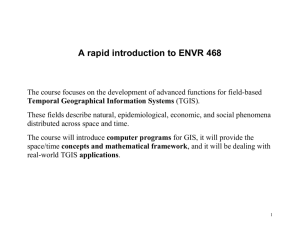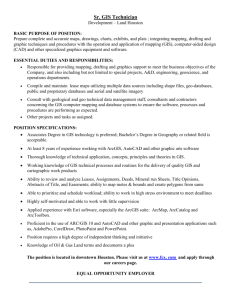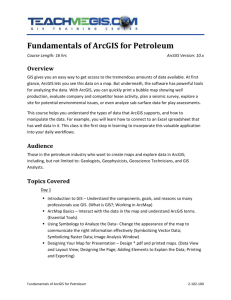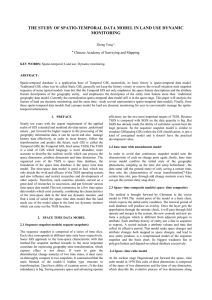A rapid introduction to ENVR 468
advertisement
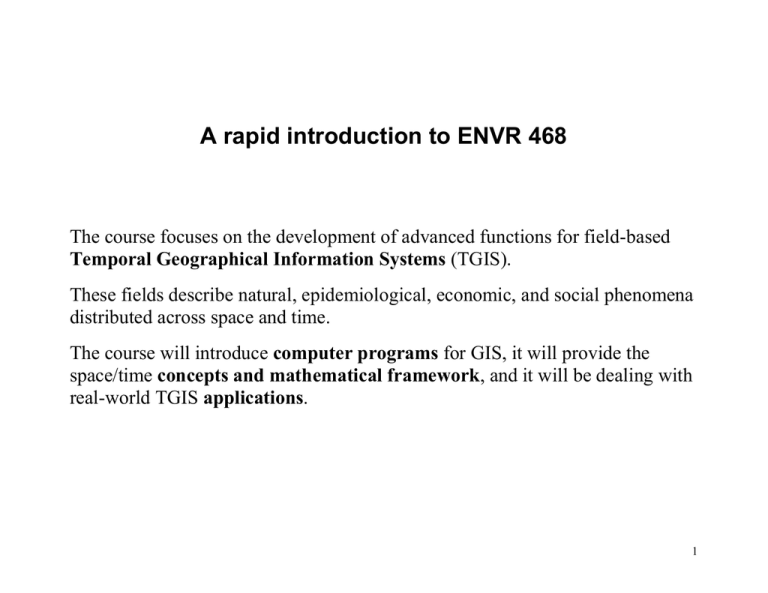
A rapid introduction to ENVR 468 The course focuses on the development of advanced functions for field-based Temporal Geographical Information Systems (TGIS). These fields describe natural, epidemiological, economic, and social phenomena distributed across space and time. The course will introduce computer programs for GIS, it will provide the space/time concepts and mathematical framework, and it will be dealing with real-world TGIS applications. 1 The computer programs: The computer programs for GIS and TGIS considered in this class are 1) ESRI arcGIS version 10 for basic GIS work, 2) The BMEGUI numerical library of space/time Geostatistical functions written in Python and MATLAB. ArcGIS has a three part interface ArcCatalog – for navigating spatial data ArcMap – for creating presentation graphics ArcToolbox – powerful geoprocessing tools 2 Concepts and mathematical tools: Review of statistics useful for Geostatistics The random variable X takes different possible values x (realizations). P[X<x] is the probability of the event “X takes a value smaller than x“. FX(x)=P[X<x] is the cumulative distribution function (CDF) of X. fX(x) = dFX(x)/ dx is the probability density function (PDF) of X. fXY(x,y) is the bivariate pdf of the random variables X and Y. fX|Y(x Y=y) is the conditional pdf of X given that Y=y. Space/Time Random fields (S/TRF) p=(s,t) is the coordinate of a point in the space/time domain. The S/TRF X(p) is a random variable indexed by the location p. Distance in the space/time domain: the space/time metric. X(p 1) and X(p 2) are two random variable, how are they correlated? 3 Variability in space and time and covariance function mx(p)=E[X(p)] is the mean trend of X(p). x2(p)=E[ (X(p)- mx(p)) 2] is the variance of X(p). cx(p,p’)=E[ (X(p)- mx(p)) (X(p’)- mx(p’)) ] is the covariance of X between points p and p’. Experimental values of cx(p,p’) are estimated using available data of X(p). A theoretical model for cx(p,p’) is obtained by fitting permissible covariance models to the experimental values of cx(p,p’). Spatiotemporal estimation and uncertainty assessment The mapping problem: Obtain estimates of X(p) at the node of a mapping grid. Prior stage: Gather the general knowledge about X(p) (moments, phys law…). Integration stage: Process the information available at the data points (hard data, …). Interpretive stage: Select an appropriate estimated value at each estimation point. Uncertainty analysis: Use the posterior pdf to completely describe mapping uncertainty. 4 The applications: The applications will consist of real-world mapping TGIS projects. Using skills acquired in basic GIS (i.e. arcGIS), each student will Research a space/time dataset of concern for society, Formulate the space/time mapping problem, and Use concepts and mathematical tools together with the BMEGUI software of space/time Geostatistics in order to provide a realistic representation of the field over space and time. Write a high quality final report that could be considered as a conference proceedings paper The space/time datasets corresponds to any fields describing natural, epidemiological, economic, and social phenomena distributed across space and time.. A dataset of concern for society could for example consist of monitoring data for an environmental contaminant found at a level that is higher than the allowed standard. The student may use her/his datasets, or use one considered in class, such as water quality data sampled by the North Carolina Department of Environmental and Natural Resources in its surface water and groundwater. The aim of this course is to prepare its participants to use its concepts, mathematical formulation and computer software to analyze their own TGIS dataset. 5 Textbook: Christakos, G., P. Bogaert, and M.L. Serre, Temporal GIS: Advanced Functions for Field-Based Applications, Springer-Verlag, New York, N.Y., 217 p., CD ROM included, 2002 Philosophy and grading: The students should learn the concepts, and not use the tools as a black box. They will be graded on solving conceptual problems rather than just applying the programs. The students will do homework’s, and a project, which will count for the final grade as follow: Homework 50% Student-defined project 50% Links to material needed for the class of fall 2015: http://www.unc.edu/mserre/teaching/fall2015/envr468/ 6
